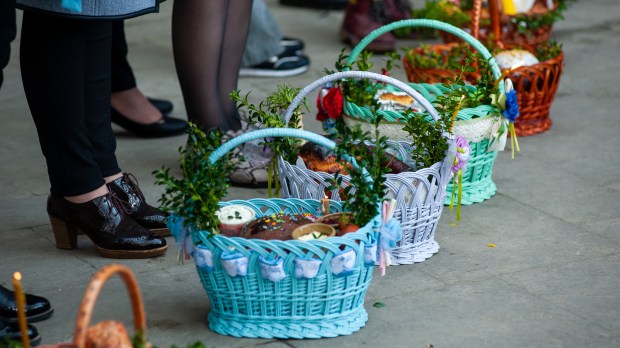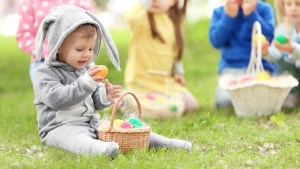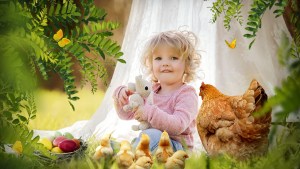When you hear the words “Easter basket,” you might think of chocolate bunnies, jelly beans, and crinkly plastic grass. But this modern image is a watered down version of the original Easter basket tradition, and the story behind it is truly lovely.
In an earlier era when Christians gave up meat, dairy products, and eggs for all of Lent, eating these things again at Easter was a very exciting and special occasion. So it became customary to bring these foods to church in a basket on Holy Saturday for the priest to bless. Then families would bring the baskets home to share the feast.
Many different cultures practiced this custom, but it seems to have been especially common in Eastern Europe.
I found a really beautiful description of the Easter basket tradition as it was practiced in Ukraine in the early 20th century, and I’d love to share it with you here. This is quoted from “Easter Red Letter Day of Year in Ukraine” from the Tacoma Sunday Ledger-News Tribune, April 22, 1962.
The Easter customs which the Ukrainian people enjoyed are rich in heritage. Their love of beauty can be seen in their hand embroidered clothes, in their folk songs, and in their beautifully decorated houses. This love of beauty permeated the rich religious holy period as well. For Easter is not a three day period but a cycle of forty days when their age old associations with man and nature comes to a religious climax in the resurrection of Christ.
Everyone gathered in front of the church on Easter day with food for the priest to bless, offering one another colored eggs and begging forgiveness for past wrongs … Each family brought a basket to be blessed by the priest on Easter morning following the resurrection services. Depending on the time schedules, this could sometimes be as early as 2 a.m.
The baskets would usually contain a paska, a rich round bread with elaborate dough ornaments, several hard boiled colorful krashanky [eggs], one or two pysanky [eggs], ham, sausage, cheese, small containers of butter, salad, and grated horseradish. The horseradish was included to remind the people of Christ’s bitter ordeal before his death. Covering the basket would be mother’s most beautiful embroidered cloth. In good weather the baskets were arranged in a circle around the outside of the church. The cloth was set aside and the candle in each basket was lit to signify new life; how they flickered in the cool spring mornings. The tired but happy parishioners would wait for the priest to sprinkle Holy Water on the beautiful array of foods, then home for a good rest.
The tradition persists in many places. There’s even a beautiful prayer for the blessing of the Easter Bread. It’s lovely to see such an ancient tradition continue today.
Whether your Easter basket holds eggs and horseradish or chocolate and marshmallow bunnies, may you and yours enjoy the happiest of Easters!



